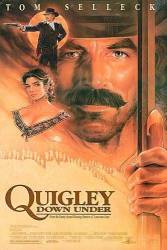Corrected entry: During the night-time firefight in the town, Quigley puts a 45 caliber, 500+ grain chunk of lead through a bad guy's thigh. Even supposing it didn't shred the femoral artery, it would have shattered the femur, making it unlikely that the evildoer could dash off into the night..
Corrected entry: Near the end of the movie, a scene opens with the sun low over the ocean. But the characters indicate it's morning. In western Australia, the ocean is to the west so the sun would be low over the water at sunset, not sunrise.
Correction: Western Australia has an extensive south facing shoreline along the Southern Ocean. There are several sections of that coast especially along the Great Australian Bight where the shoreline faces east.
Except that this was supposed to be Fremantle WA, as you can see buildings from the first part of the movie where we were told that they were in Fremantle. The Indian Ocean is west of Fremantle.
Corrected entry: Near the end, on the mountain, Quigley is in a standoff with one of the henchmen. Suddenly he is shot in the leg, but there is no shot heard in the film.
Correction: Don't know if it was corrected for disc, but there is a clear gunshot heard accompanying the bullet strike on my copy.
Corrected entry: Quigley is an extreme long range rifle shooter. Why take on all Marston's thugs when he could easily take out Marston from long range? He proved he could take out Marston from extreme long range when he shot the two thugs next to Marston.
Correction: Many reasons are possible. Quigley may have wanted to be sure it was actually Marsten and not (as we see in the film) one of his henchmen wearing his clothes.
Corrected entry: In the beginning of the film, when Quigley is fighting over the girl, the third man is hit in the nose. Before he can put his hand to his nose, there is blood on his hand.
Correction: The thug punched in the nose is the same thug that Crazy Cora had bitten the ear of. After she bit him he looked at the blood on his hand, then went after her. That is why the blood was on his hand BEFORE he got hit.
Corrected entry: In the scene when Quigley and Crazy Cora have passed out due to exhaustion and dehydration (after walking through the desert) they are seen lying on the sand. There is a slide mark where Quigley apparently dropped and slid. The slide mark does look like the path that his torso made, but there are no marks made from his legs and there are no marks at all where he dropped Cora. In fact, she is lying perfectly straight and face up. He was carrying her over his shoulder. It is very unlikely that she would have ended up in this position.
Correction: Unlikely doesn't mean impossible. Since we don't see the actions that cause the impressions in the sand we can't say the way they look or the way the people are positioned are mistakes.
Corrected entry: When Quigley shoots the log, he does not reload his gun before he shoots at the next man just before his capture.
Correction: After he shoots the rope to release the log, we see several seconds of the log striking the man and him then rolling down the hill. Quigley had more than enough time to reload.
Corrected entry: In the scene with Alan Rickman just before the final gunfight, Tom Selleck's hands are tied in front of him. The henchmen cut the rope with a knife, leaving the knotted rope around both wrists. As the pistol is placed in his belt for the gunfight, there are no ropes around his wrists.
Correction: If you watch, just after the ropes are cut and before the weapon is placed in Quigley's belt, you can see Quigley, untie first his right hand and then throw of the rope from his left, just before the cut.
Corrected entry: Quigley leaves crazy Cora in the cave to go the closest town. The bad guy told him the town was to the southwest. As Quigley is riding, the sun is setting on his left, which should be east if he was riding to the southwest.
Correction: Depending on the time of year and the route of travel to head to the town, Quigley is still heading in the general direction of the setting sun.
Corrected entry: Right at the start of the movie they show a map illustrating Quigley's travel from San Francisco to Fremantle. As the camera pans across Australia we see a large portion of the north east of the country labelled as North Australia. Quigley is a civil war veteran which means the film must be set after 1865, by which time the Australian state of Queensland had been created. The map is incorrect for the time of the movie. (00:01:10)
Correction: I have a copy of the screenplay signed by Simon Wincer. It says that the map is 'old, frayed at the edges, practically a sepia antique'. They deliberately chose a very old map for the shot.






Correction: It's entirely possible the bullet missed both the bone and the artery.